The Ti-E PFS is an excellent automatic focusing system. Using the system hinges on one key aspect: The NIR LED used for focusing.

The PFS is basically a laser reflection system. A near IR LED is delivered into the back of the objective, and emitted into the specimen. When the light hits a refractive index change of a sufficient value, some of the light is reflected and bounces back into the objective. This point of reflection is then sampled on a linear CCD array, becoming the reference position for measuring the distance between the objective and the specimen (or a measurement of the distance between the objective and the RI change).
So: what is required for the system to work?
- Refractive Index change sufficient to cause reflection.
- NIR Blocking filters that stop other sources of NIR (800nm+) light from entering the optical path.
- Specimen can not cause excessive light scattering (thick tissue sections will do this)
- Coverslip, or glass bottom dish with a thickness specification of No.1S.
- An objective compatible with the PFS system.
- Proper information on the objective entered into the microscope hub.
Nikon has a more specific explanation of the PFS requirements and operational theory below:
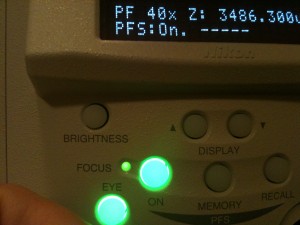
So, if you have a suitable specimen, how will the PFS work? The user controls are straightforward. At left is an image of the control face for a Ti-E with PFS. Note the buttons for “ON”, “Memory” and “Recall”. These are basically the only panel controls for the system. The small “Focus” light indicates when the laser sensor is receiving a signal. Basically, if you focus manually on your specimen, and look at the “focus” light, it should be illuminated green. If so press “on” and the PFS should beep and lock. If this works, use the external PFS offset knob to set the offset lens position, and begin your imaging.
On the other hand, what happens if things don’t work as they should? Here are some in-vivo pictures I snapped of various errors with the system. Each picture includes a comment which describes the problem.
Note that there are 3 beep codes and modes of behavior for the “on” light for the PFS.
Solid Green light = System on and locked
Flashing light = System on, and searching for a LED signal, but either is out of focus or specimen/lens combo is not achieving adequate RI change.
Long Solid beep sound, flashing light stops = System has timed out searching for the reflection feedback. Press “on” again to retry.
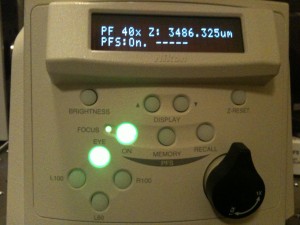
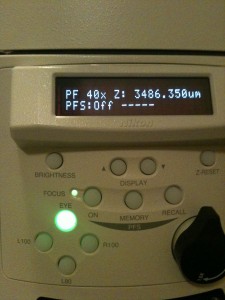
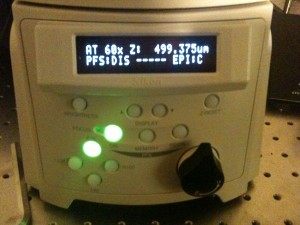
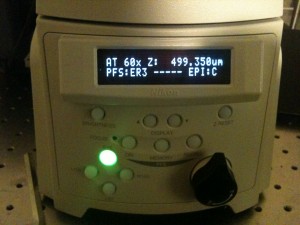
There are some other errors which may appear when using the PFS, depending on what might be wrong with the configuration. Below is a complete list of errors from Nikon’s troubleshooting guide for the PFS. If you can’t get your PFS system working with your specimen after going through this guide, feel free to contact me, or your local Nikon rep!
-Austin
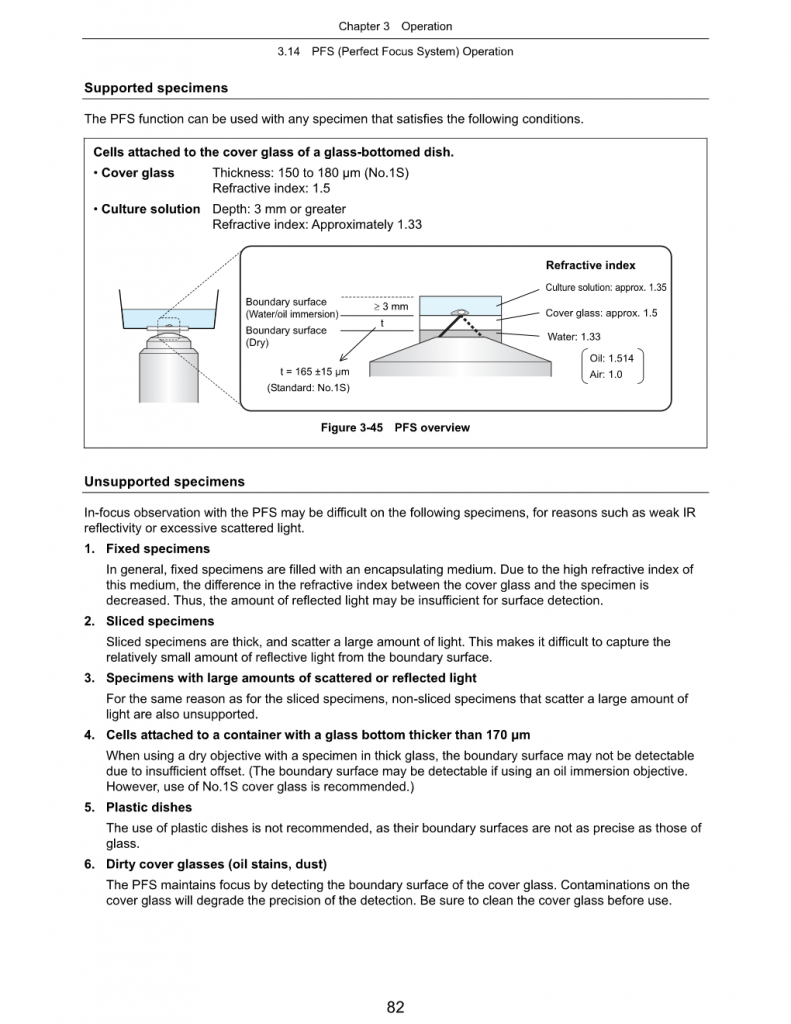
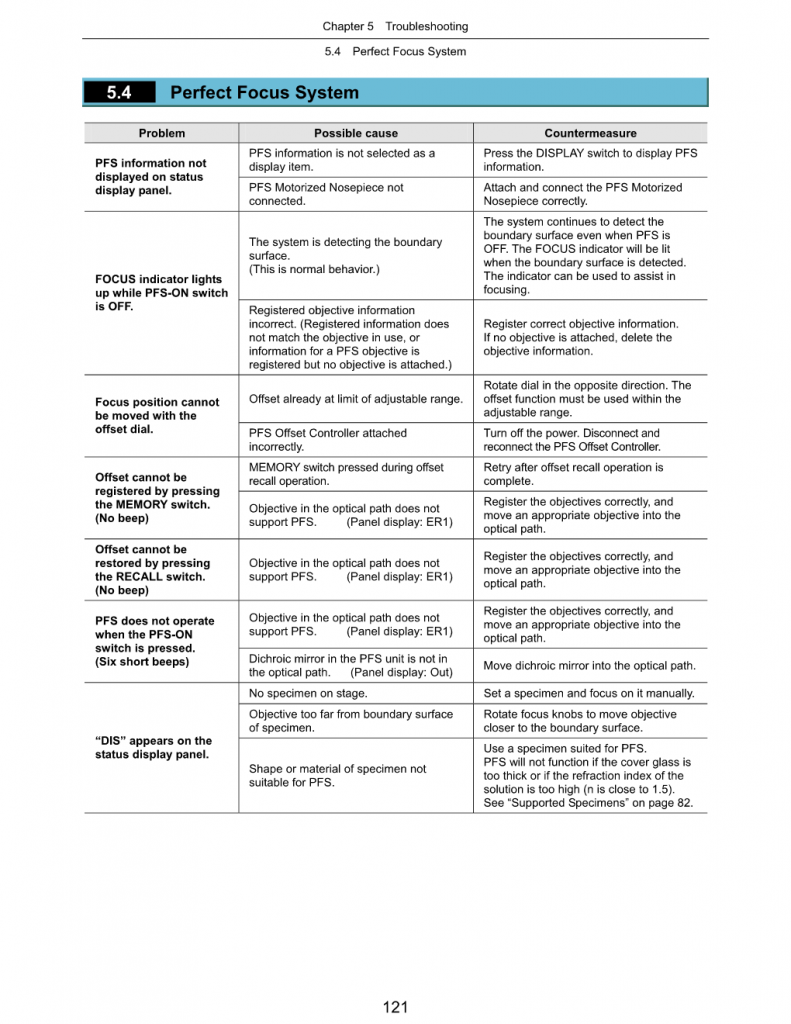
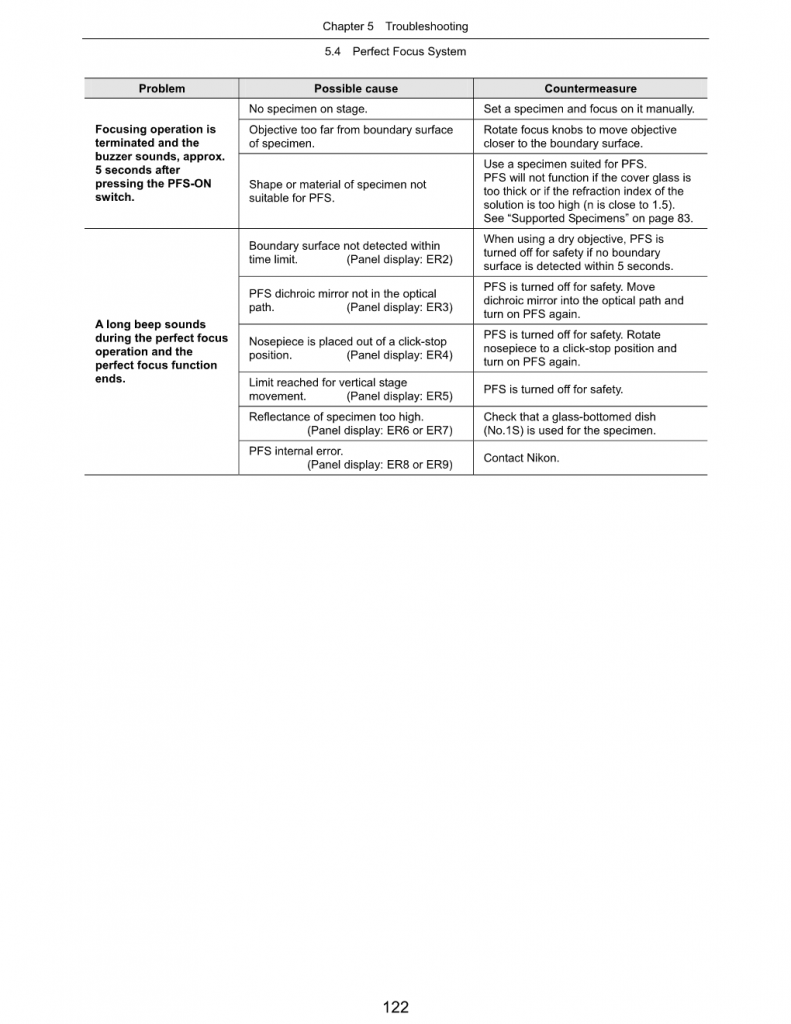
Comments
10 responses to “Ti-E Perfect Focus Usage and Troubleshooting”
Hello Austin,
I have a problem with our Nikon PFS. Our Nikon TiE has been refurbished for TIRF microscopy. We Time-Lapse live cells with a temp.res. of +/-20min in multi well chambered coverglasses over multiple days.
The problem we regularly encounter, is that the PFS leaves the focal plane during acquisitions WITHIN one well (so it rules out any reflection due to glue used to attach the walls of the wells). And when it leaves the plane, it regularly jumps 30+ um up or down (random).
The specimen fulfills all the requirements for the PFS to work (thickness of the Coverslip, 1.518 RI oil, 3+mm medium on the cells).
Maybe you have an idea what could be the problem here.
If you need any more info, I’ll be happy to answer your questions.
Kind regards,
René
Hi Rene,
I assume you are moving the wellplate from site to site as you acquire the timelapse? If so it could be loss of oil as the objective moves around under the plate. How far are you moving and how many wells are you imaging per experiment?
Hello Austin,
I’ve been using the PFS for ICC. I’ve encountered a problem when I use a 40x or 60x oil lens. The PFS goes out of focus when taking multipoint images.
Is this due to the wrong objectives? Can this be solved?
Kind regards,
Neill
Thanks for the question – most likely this is caused by a break in the oil to glass interface. If the oil thins out too much, the PFS lock will break, and once you arrive at the final position, you won’t have a valid focus. There are 2 ways to solve this. 1. try dropping the objective to the escape position, then moving, then refocusing. (for a long distance). 2. If moving only a short distance, try adding a bit more oil to the interface, and/or switching to a more viscous oil. Hope this helps!
Hi Austin,
Our PFS systeem seems to have trouble maintaining focus when cells move to a higher focus plane, for example cells going into mitosis. This results in the PFS shifting focus to the single cell in the higher plane, and a loss of frames for periods of 30 – 120 mins.
Do you have any recommendations on how to setup or calibrate the PFS so maintain focus on the field of cells in the initial focal plane?
Kind regards,
Harmen
The PFS should be locked onto a reflection of the LED/laser dot onto either the bottom surface of your sample, or another interface of air/glass, or glass/oil etc. So it shouldn’t be tracking one cell when it moves. What objective are you using, and what model of scope is it? Ti-E? Also – Is the used objective indicated on the scope? E.g. does the scope say “40x” when really you are using a 100x oil?
I have a problem with our Nikon Ti2E microscope PFS. Our Nikon Ti2E has been refurbished for TIRF microscopy with an EMCCD camera. The PFS works fine. But when I click the “run” button in the software to collect the wide-field image, the PFS is automatically off. I think this is a software setting problem. Would you please give me a head up on this problem?
Thank you~
Apologies for my slow reply David! You are correct that the problem is with software. In your control program (Elements, or MetaMorph perhaps?) there is typically a choice to either ignore the PFS, or to use it, and then set it in, or off, and set the offset value. In many cases the simple solution is to detach control of the PFS from the software and manually set it.
-Austin
Dear Austin,
Our PFS works perfectly with our 20X but when we try switching to the 40X (no oil for both) the PFS won’t even let us turn it on. Do you have an idea of how we might trouble shoot this? We’ve checked and the correct objective is indicated on the scope.
Best,
Catherine
Hi Catherine,
Apologies for my slow answer!! Have you checked the position of the PFS beam reflecting mirror on the scope? If this is removed you can get a situation like you describe. You also may have a hardware problem with the unit if it won’t enable at all. In most cases, it won’t turn on if the reflected focus tracking beam is not detected by the sensor in the scope – so for instance if you try activating it with the sample removed, it will fail.
-Austin